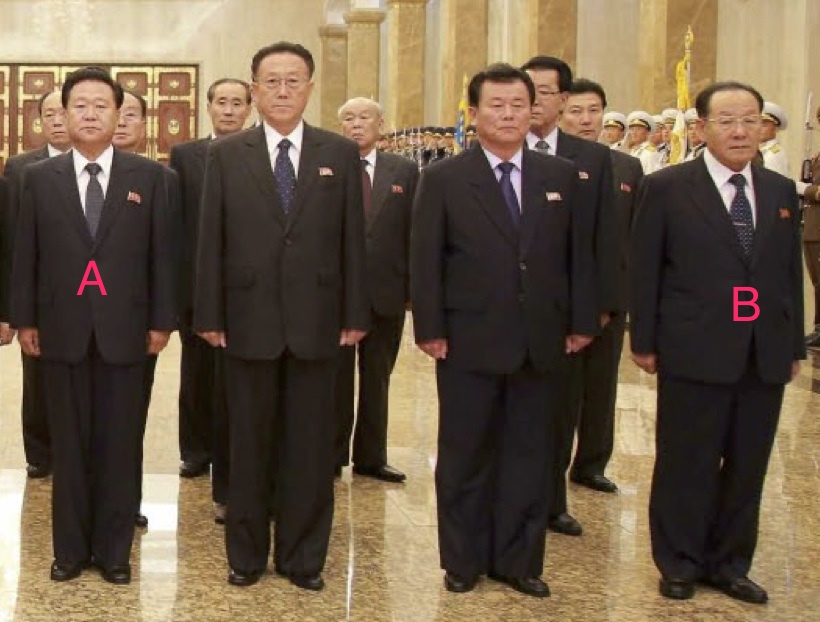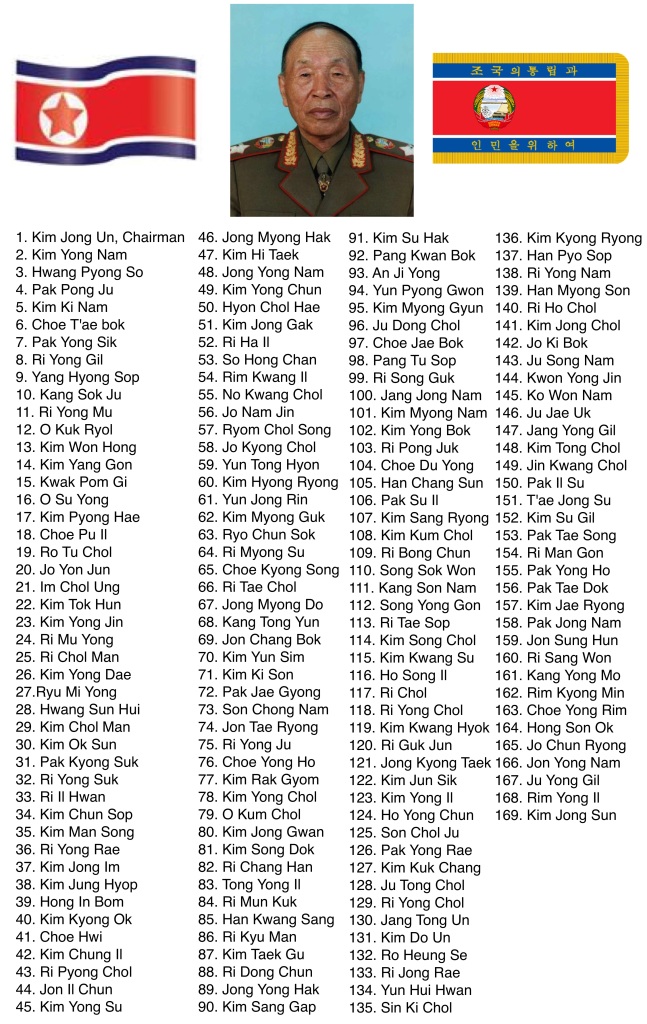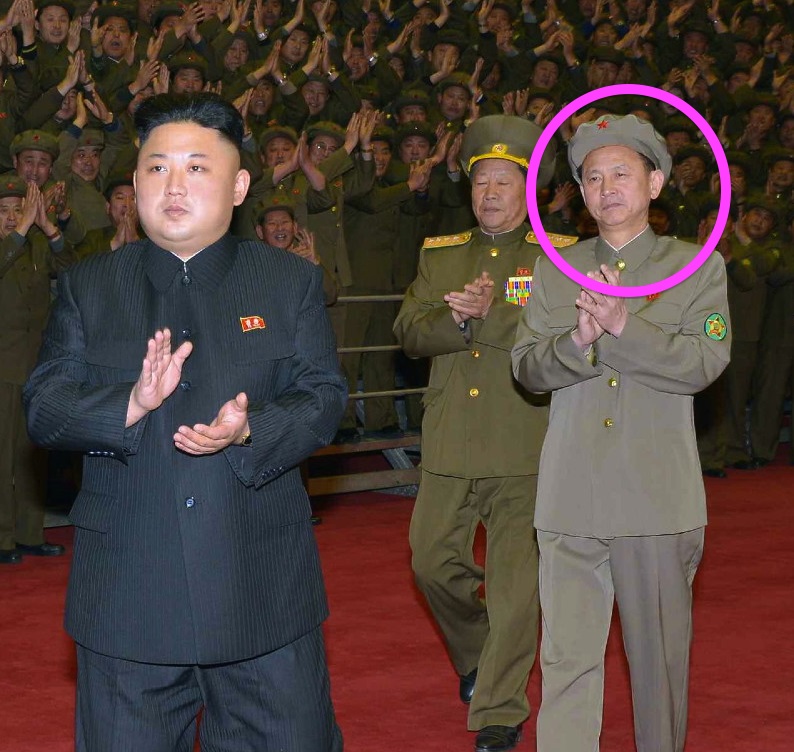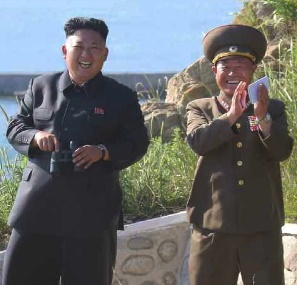The Education of Choe Ryong Hae
North Korea’s political culture recently attracted a spate of new international media attention when Choe Ryong Hae, a member of the nation’s core elite, disappeared from public view.[1] For 18 months, Choe had served as a senior Workers’ Party of Korea (WPK) Secretary and a member of the WPK Political Bureau’s Presidium (or standing committee). In this capacity, he supervised the construction or opening of orphanages and youth centers, presided over numerous events, and appeared at on-site visits with Kim Jong Un.
Figure 1. Choe Ryong Hae (A) lines up with other members of the WPK Secretariat at Kumsusan Palace of the Sun on October 10, 2015.

These public activities and senior positions were soft landing assignments for Choe Ryong Hae when he last found himself in peril in the spring of 2014. At that time, Choe was removed as director of the Korean People’s Army (KPA) General Political Department,[2] the leading political management position for North Korea’s armed forces, amid accounts of squabbling over foreign trading corporations and allegations of financial impropriety.
In contrast to a number of other rumors circulated in ROK media about dismissed or “purged” elites, discussions of Choe’s disappearance include no claims that he has been incarcerated or sent to be shot. Accounts of Choe’s removal from DPRK public life, if not from office, are split as to where he has ended up. The reason for the most recent disciplinary action against him also remains murky. ROK sources have suggested it is due to Choe’s failure to adequately manage a project resulting in shoddy construction of the facility. However, someone of Choe Ryong Hae’s status is not dismissed or sent for re-education over one peccadillo.
ROK officials and experts are justifiably circumspect in their assessments about Choe Ryong Hae’s punishment.[3] According to Yonhap, citing two different unnamed officials, it’s currently a toss-up as to whether Choe has been sent for intensive indoctrination and interrogation at the Kim Il Sung Higher Party School,[4] or to work at a rural farm—a labor assignment treated in the DPRK as a form of re-education.[5]
The first sign of Choe’s shaky standing in the regime was his exclusion from the state funeral committee for KPA Marshal Ri Ul Sol, who died in early November.[6] Initial speculation claimed that Choe was excluded due to poor health, but the funeral committee members include a number of senior officials who are quite elderly or who are well known to have terminal illnesses or chronic health problems.
In addition to his absence from Ri Ul Sol’s state funeral committee, Choe Ryong Hae has failed to appear at several events which he normally would attend in his capacity as a central party secretary or as the head of the country’s workers’ and social organizations. His typical commitments have included meetings of the central committees of the women’s union and the youth league, as well as events related to the Three Revolutions movement.
What’s in a Funeral List?
Figure 2. State Funeral Committee for Marshal Ri Ul Sol.

“Pyongyangologists” (myself included) will sometimes infer too much from state funeral committee rosters, which can include dozens or even hundreds of names. The DPRK holds only one state funeral per year and assigns a number to each top official in the associated planning group, practices that can encourage Pyongyang watchers to treat the annual committee list as a Billboard chart or a sports ranking of North Korean elites. This comparison is not necessarily accurate, however. Rather, funeral committee members are listed together in specific institutional cohorts—groups of officials who share related formal positions—with some cohorts assigned priority over others based on whether the deceased was from the party, military or Cabinet.
Still, as a member of the Political Bureau Presidium and WPK Secretariat, Choe Ryong Hae should have appeared on the funeral list’s “Top 10” or at least its “Top 20,” regardless of his actual influence or importance. Moreover, Choe’s participation in the previous four state funeral committees makes his absence in the latest group particularly notable.[7] In a more subtle sign that Choe had fallen from favor, his underlings who lead North Korea’s larger social and labor organizations were the last listed funeral committee members.[8]
Perhaps more importantly, the state funeral committee list dealt a setback to earlier estimates by outside analysts that Kim Jong Un had removed scores of first-tier officials in an effort to consolidate power. The funeral committee included the names of over a dozen party and military leaders[9] who were rumored to have been imprisoned or executed during the last five years; apparently, they had just retired.[10]
We Don’t Wanna Go, We Gotta Go
Figure 3. O Il Jong Chon (right) with Kim Jong Un.

Choe’s exclusion from Ri Ul Sol’s funeral committee was not an isolated incident. Several party and military elites who have worked as close aides to Kim Jong Un during the last four years also did not make the list. The most notable exclusion from the funeral committee was O Il Jong, who had served for five years as director of the WPK Military Affairs Department. Like Choe Ryong Hae, O Il Jong is a second-generation princeling whose career initially flourished with Kim Jong Un’s hereditary succession. Like Choe, O was also a member of the four prior funeral committees.
It is most likely no accident that O and Choe were left off the funeral committee together. Choe’s recent career setback, according to some ROK-based experts, was due to faulty construction of the Paektusan Youth Power Station. In a rush to complete the power station for the 70th anniversary of the WPK in October, laborers from the Kim Il Sung Youth League (part of Choe’s portfolio) and KPA construction personnel (under O’s oversight) did a “slipshod job,” according to comments attributed to project participants.[11] It needs to be underscored, however, that the power station project was not the primary reason, but instead a last straw that led to their banishment.
If the decisions to exclude Choe and O from the funeral list were indeed related, the disciplinary actions were likely a response to troubles at the jointly built Paektusan power plant and other joint projects. Yet it is not unusual for the workers’ organizations under Choe’s charge to support KPA activities. In addition to their routine contributions to national defense in the form of reserve military training units,[12] workers’ organizations collaborate with elements of the KPA to complete large-scale critical infrastructure (public works) projects.[13] Every North Korean official dismissed or even executed since Kim Jong Un’s accession has been involved in state construction projects, and Choe and O were primary senior officials involved in coordinating and managing these civil-military activities.[14]
Figure 4. Colonel-General Pak Jong Chon (right) with Kim Jong Un.

Also excluded from the funeral committee is Kim Jong Un’s close military aide and vice chief of the KPA General Staff, Colonel-General Pak Jong Chon. Pak has been involved in the test of numerous weapons systems, and his ties to the current leader go back to 2009. However, he was not listed among the KPA’s corps commanders or second officials of the KPA General Staff on the funeral committee.
Along with Colonel-General Pak,[15] Hong Yong Chil, a deputy director in the WPK Military Industries Department (Machine-Building Department), was not listed on the funeral committee with other WPK deputy (vice) department directors. Both Pak and Hong were previously on Jon Pyong Ho’s funeral committee. Both men also slipped from public view at the same time as Choe Ryong Hae.
Ma Won Chun and Jo Yong Won, both from the party’s construction and planning sectors, were also excluded from the funeral committee. Ma is the DPRK’s master architect-cum-builder and Jo is likely from the party’s finance and accounting department. Ma’s status has been questionable since May 2015, when he was rumored by ROK officials to have been executed. Following Ri Ul Sol’s funeral, Jo Yong Won was observed attending an on-site visit to a children’s food factory with Kim Jong Un.
If Choe Ryong Hae’s exclusion from Ri Ul Sol’s state funeral committee is taken with the exclusion of other officials closely linked to Kim Jong Un,[16] then it is highly probable that Choe is not alone among his peers and colleagues in receiving re-education. Just prior to Choe and these other officials going to ground, North Korea announced that the WPK will convene its 7th Party Congress, the first in 35 years. The Party Congress is the WPK’s supreme power organization, and its upcoming meeting allows Kim Jong Un the best opportunity to make his own policies and pick the people to implement his policies. That congress convenes in six months, the average length of time a senior official undergoes the re-education curricula at the Kim Il Sung Higher Party School. Perhaps at that time, Choe Ryong Hae and other disappeared elites will reappear at the Party Congress after successfully completing their re-education.
____________________
[1] Choe Ryong Hae’s last public appearance, by name, was on or around October 21, 2015.
[2] “The Fall of Choe Ryong Hae” by Michael Madden, 38 North, May 2, 2014, https://www.38north.org/2014/05/mmadden050214/.
[3] Choe’s disappearance and reported punishment was carried out by Jo Yon Jun, senior deputy director of the WPK Organization Guidance Department, who has served as Kim Jong Un’s chief disciplinarian of senior cadres.
[4] Established around 1972, the Kim Il Sung Higher Party School (sometimes called the Kim Il Sung School for Higher Officials) educates and trains WPK cadres destined to work in the central party. The school also has courses of study (an intensive combination of political education, interrogation, indoctrination and “reform through labor”) for mid- and late-career senior party officials. An image of the KIS Higher Party School can be seen here https://nkleadershipwatch.files.wordpress.com/2015/11/kishpepy.jpg.
[5] Kim Kwang-tae, “N. Korean leader sent his key aide to top school for re-education,” Yonhap News Agency, November 12, 2015, http://english.yonhapnews.co.kr/northkorea/2015/11/12/0401000000AEN20151112002900315.html.
[6] “Ri Ul Sol Funeral Committee: Who’s On, Who’s Not,” NK Leadership Watch, https://nkleadershipwatch.wordpress.com/2015/11/09/ri-ul-sol-funeral-committee-whos-on-whos-not/.
[7] These are the state funeral committee of Vice Marshal Jo Myong Rok (November 2010), Kim Jong Il (December 2011), Kim Kuk Tae (December 2013) and Jon Pyong Ho (July 2014).
[8] The last four names which close out Ri Ul Sol’s funeral committee are: Jon Yong Nam (Chairman of the Kim Il Sung Youth League Central Committee); Ju Yong Gil (Chairman of the Federation of Trade Unions of Korea Central Committee); Rim Yong Il (Chairman of the Union of Agricultural Workers of Korea Central Committee) and Kim Jong Sun (Chairwoman of the Korean Democratic Women’s Union Central Committee).
[9] Among the officials on the funeral committee who were rumored to have been imprisoned or executed were: Vice Marshal Kim Yong Chun; Vice Marshal Kim Jong Gak; General Jong Myong Hak; General Jong Myong Do; Colonel-General Jon Chang Bok; Kim Kyong Ok; and, Han Kwang Sang.
[10] When Kim Jong Un assumed power, a number of DPRK senior officials disappeared from public view, though some disappearances were more gradual than others. The prevailing analysis was that these officials were purged due to Pyongyang’s long-standing practice of lifetime job appointments for senior officials. However, starting in 2010—around the time of Kim Jong Un’s rise to power—senior officials retired from office.
[11] Choi Song Min, “Site workers reveal details of careless power plant construction,” Daily NK, November 3, 2015, http://www.dailynk.com/english/read.php?num=13551&cataId=nk01500.
[12] The Kim Il Sung Youth League contributes an estimated 1.1 million members to its reserve military training unit, the Young Red Guards. As part of their youth league activities, the Young Red Guards participate in weekly mandatory drills and hundreds of hours of training and education activities. Other workers’ organizations such as the trade unions and agricultural union contribute to the Worker-Peasant Red Guard and other reserve military training units. These activities are coordinated by the WPK Workers’ Organizations Department, the WPK Military Affairs Department and the WPK Civil Defense Department in cooperation with the Ministry of the People’s Armed Forces and the KPA General Staff Operations Bureau.
[13] “Occupational Hazard: North Korea’s Construction Business and Its Effect on DPRK Elite Careers,” a working paper by Michael Madden (forthcoming, winter 2015).
[14] The common denominator here, the institution that would be privy to these institutional linkages (one monitoring these activities and regulating the military when necessary) is the KPA General Political Department (General Political Bureau). The GPD, which Choe which publicly led from 2012 to 2015, would have enough clout and influence to dislodge Choe and O from their positions, albeit temporarily, and might have very good reason so to do.
[15] Pak Jong Chon has also been subjected to military demotion, losing a star and reduced to Lieutenant General during 2014 and 2015. At last check, Pak’s third star (Colonel-General) had been restored.
[16] A future analysis will discuss the methodical and ingenious way Kim Jong Un has orchestrated the numerous personnel changes that have occurred since he assumed power four years ago.
